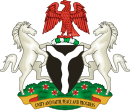| This article is part of a series in |
| Culture of Nigeria |
|---|
 |
Filmmaking in Colonial Nigeria generally refers to an era in Nigerian cinema, usually spanning the 1900s through to the 1950s, when film production and exhibition or distribution were controlled by the British colonial Government. The history of cinema in Nigeria dates back to as early as the history of film itself; notably in the late 19th century, with the use of peephole viewing of motion picture devices.[1] These were soon replaced in the early 20th century with improved motion picture exhibition devices, with the first set of films screened at the Glover Memorial Hall in Lagos from 12 to 22 August 1903.[2][3]
Filmmakers started producing films for local audiences within Nigeria since the 1920s, mostly employing the mobile cinema as a means of exhibition;[4] the earliest feature film made in Nigeria is the 1926's Palaver produced by Geoffrey Barkas. The film was also the first film ever to feature Nigerian actors in a speaking role[5][6] The Colonial Government largely utilized the cinemas as a tool to propagate British ideals, as well as to promote religious propaganda.[3]
The Nigerian Film Unit was established in 1949. By 1954, mobile cinema vans played to at least 3.5 million people in Nigeria, and films being produced by the Nigerian Film Unit were screened for free at the 44 available cinemas. The first film entirely copyrighted to the Nigerian Film unit is Fincho (1957) by Sam Zebba; which is also the first Nigerian film to be shot in colour.[7] The film is also regarded as a transitional film into the Golden era.[8]
- ^ "X-raying Nigerian Entertainment Industry At 49". Modern Ghana. 30 September 2009. Retrieved 13 April 2015.
- ^ Cite error: The named reference
autogenerated2was invoked but never defined (see the help page). - ^ a b Olubomehin, Oladipo O. (2012). "CINEMA BUSINESS IN LAGOS, NIGERIA SINCE 1903". Historical Research Letter. 3. ISSN 2224-3178.
- ^ "Nigerian Film Unit". Colonial Film. Retrieved 29 March 2015.
- ^ Ekenyerengozi, Michael Chima (21 May 2014). "Recognizing Nigeria's Earliest Movie Stars - Dawiya, King of the Sura and Yilkuba, the Witch Doctor". IndieWire. Shadow and Act. Archived from the original on 29 May 2014. Retrieved 13 April 2015.
- ^ "PALAVER: A ROMANCE OF NORTHERN NIGERIA". Colonial Film. Retrieved 13 April 2015.
- ^ "Lights, Camera, Africa!!!". Goethe Institute. Retrieved 24 August 2015.
- ^ "Evolution of the Nigerian film industry". Pulse Nigeria. 2017-02-16. Retrieved 2020-01-22.